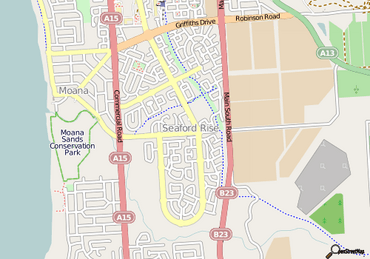Seaford Rise, South Australia facts for kids
Quick facts for kids Seaford RiseAdelaide, South Australia |
|||||||||||||||
|---|---|---|---|---|---|---|---|---|---|---|---|---|---|---|---|
 |
|||||||||||||||
| Postcode(s) | 5169 | ||||||||||||||
| LGA(s) | City of Onkaparinga | ||||||||||||||
| Region | Southern Adelaide | ||||||||||||||
| County | Adelaide | ||||||||||||||
|
|||||||||||||||
Seaford Rise is a suburb located in Adelaide, South Australia. It's part of the City of Onkaparinga. Imagine a map: its edges are marked by Griffiths Drive to the north, Commercial Road to the west, Main South Road to the east, and it shares a border with Maslin Beach to the south.
Contents
History of Seaford Rise
Seaford Rise is built on land that used to be farms. This area is southwest of the bend in the Onkaparinga River at Noarlunga. Farmers first settled here during a "farming boom" in the 1840s and 1850s.
Early Farming Life
At first, farming was very successful. Early European settlers quickly cleared the natural plants and started growing cereal crops. Wheat was the main crop grown in the area. Because farming was doing so well, a flour mill was built nearby in Old Noarlunga. This helped that town grow too.
Changes in Farming Methods
Families like the Teakle, Robinson, Jared, Oliver, and Martin families farmed the land where Seaford Rise is now. They soon learned that relying only on wheat was risky. By the late 1860s, the soil was tired from growing the same crops over and over. The amount of crops they could harvest, called "yields," became very low.
So, farmers changed their methods. They started doing "mixed farming." This meant they raised sheep and chickens, had small dairies, and grew different types of cereal crops. This new way of farming was profitable enough for them to live on smaller pieces of land for a while.
From Farms to Suburbs
This mixed farming continued for almost 100 years. But by the mid-1900s, many changes started happening to the land. More and more people from Adelaide were moving south. Also, tourism became popular along the beaches.
Because of this, farming slowly stopped. The government and private companies bought land to build new homes and expand the suburbs. This is how Seaford Rise became the residential area it is today.

